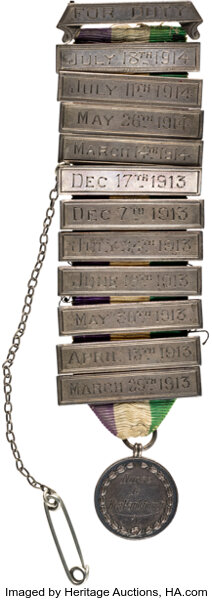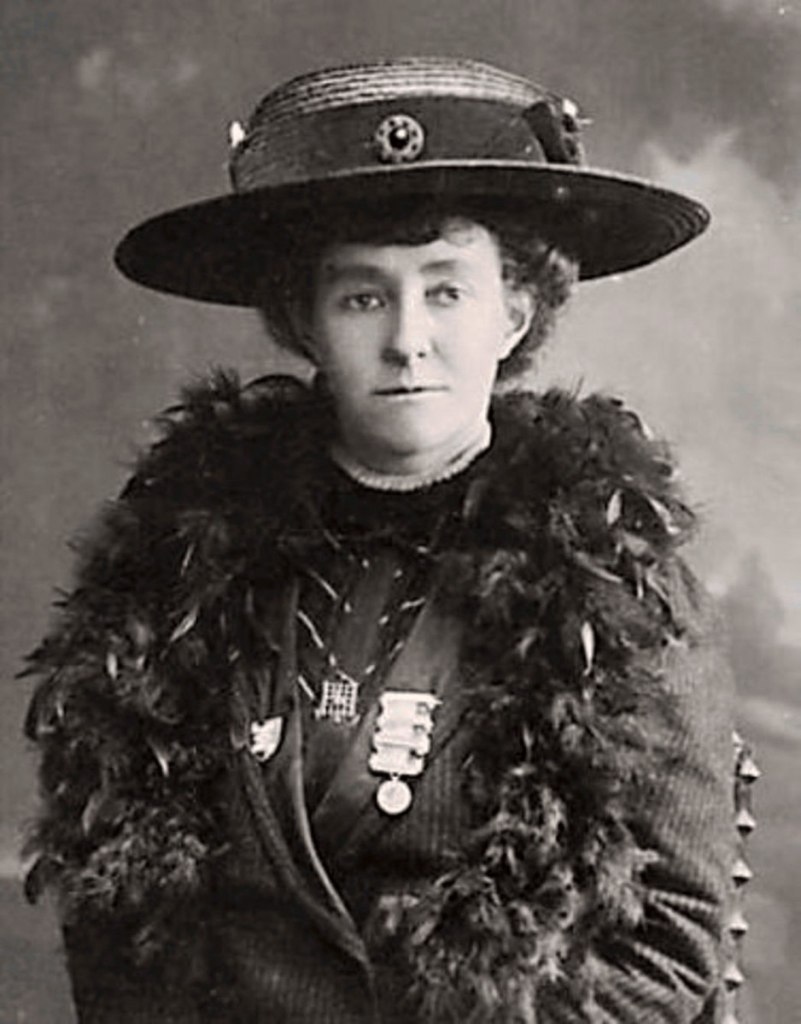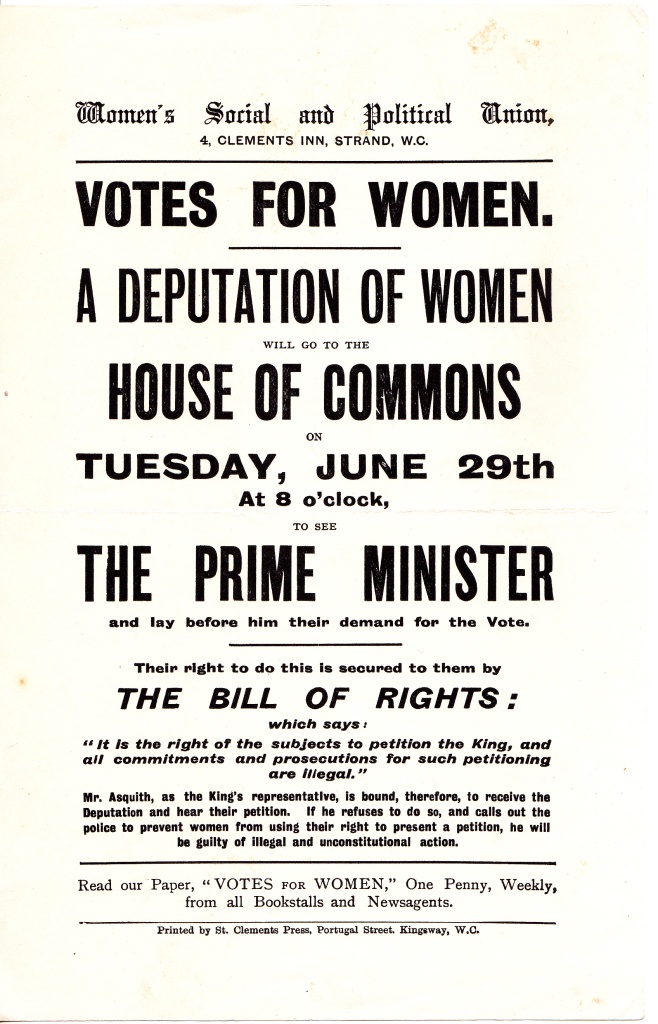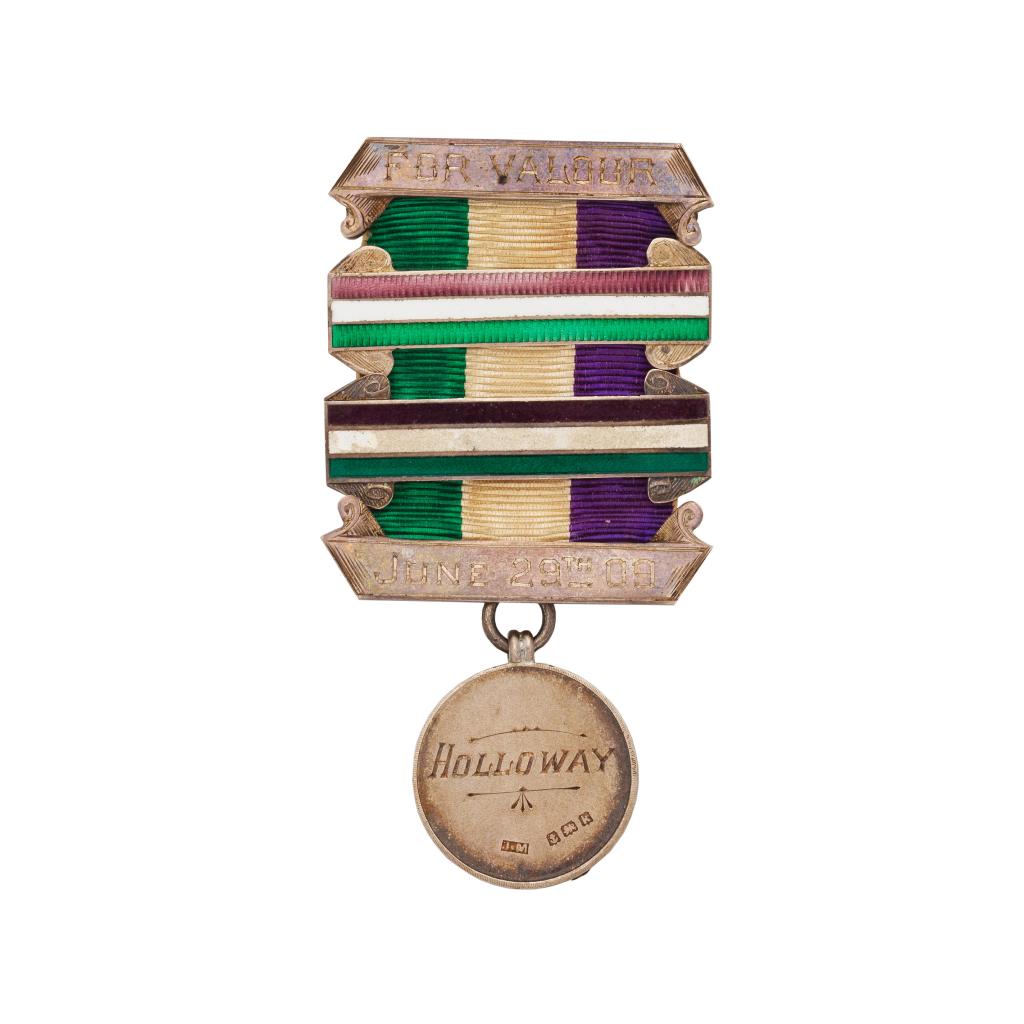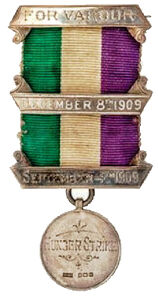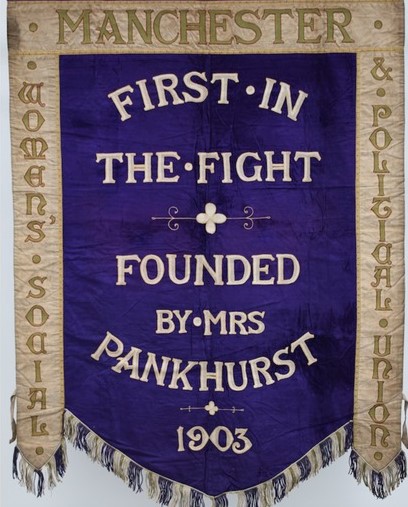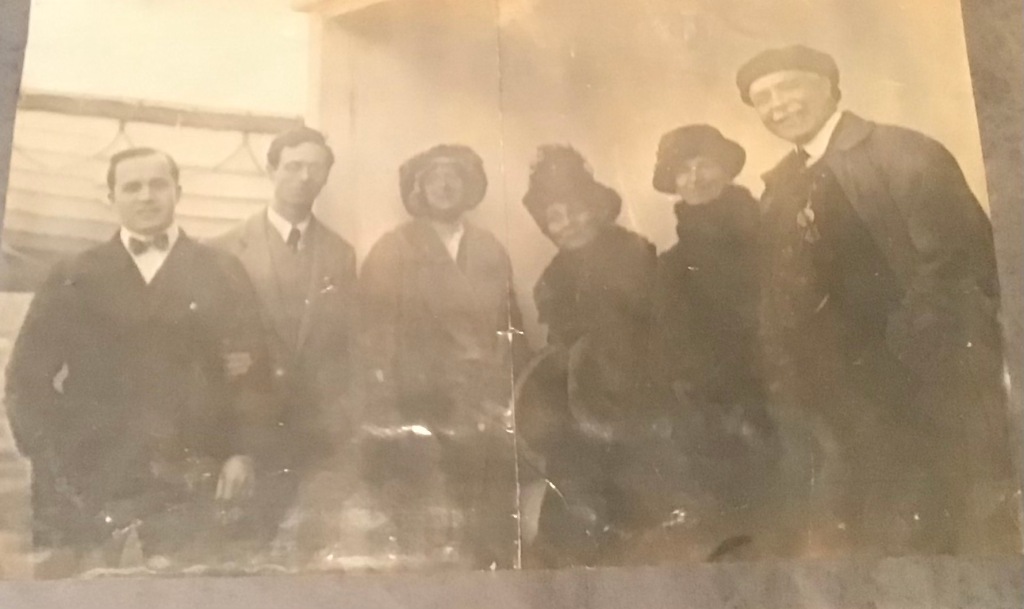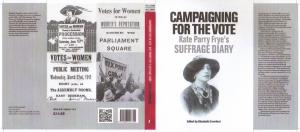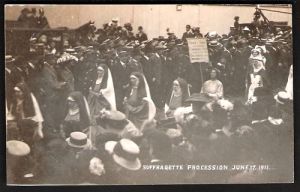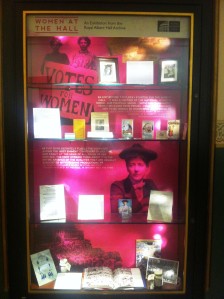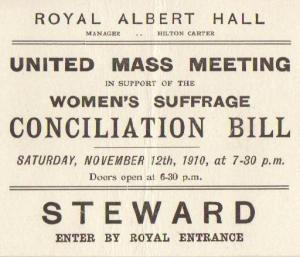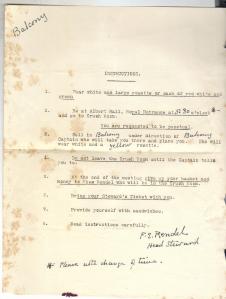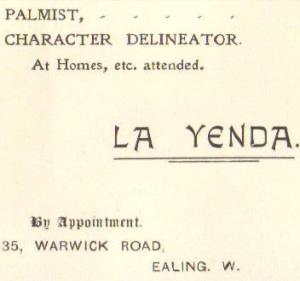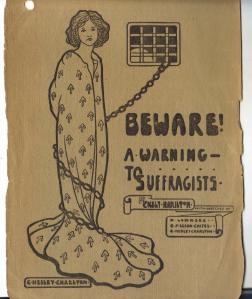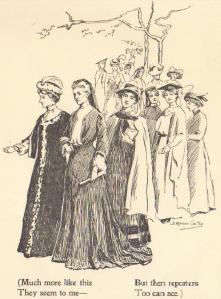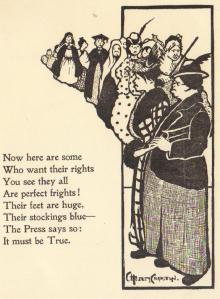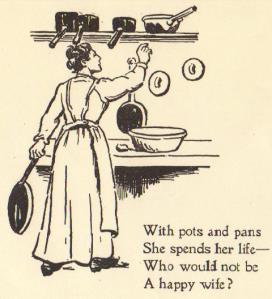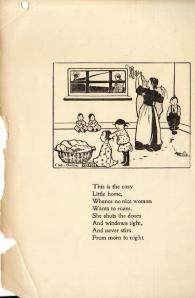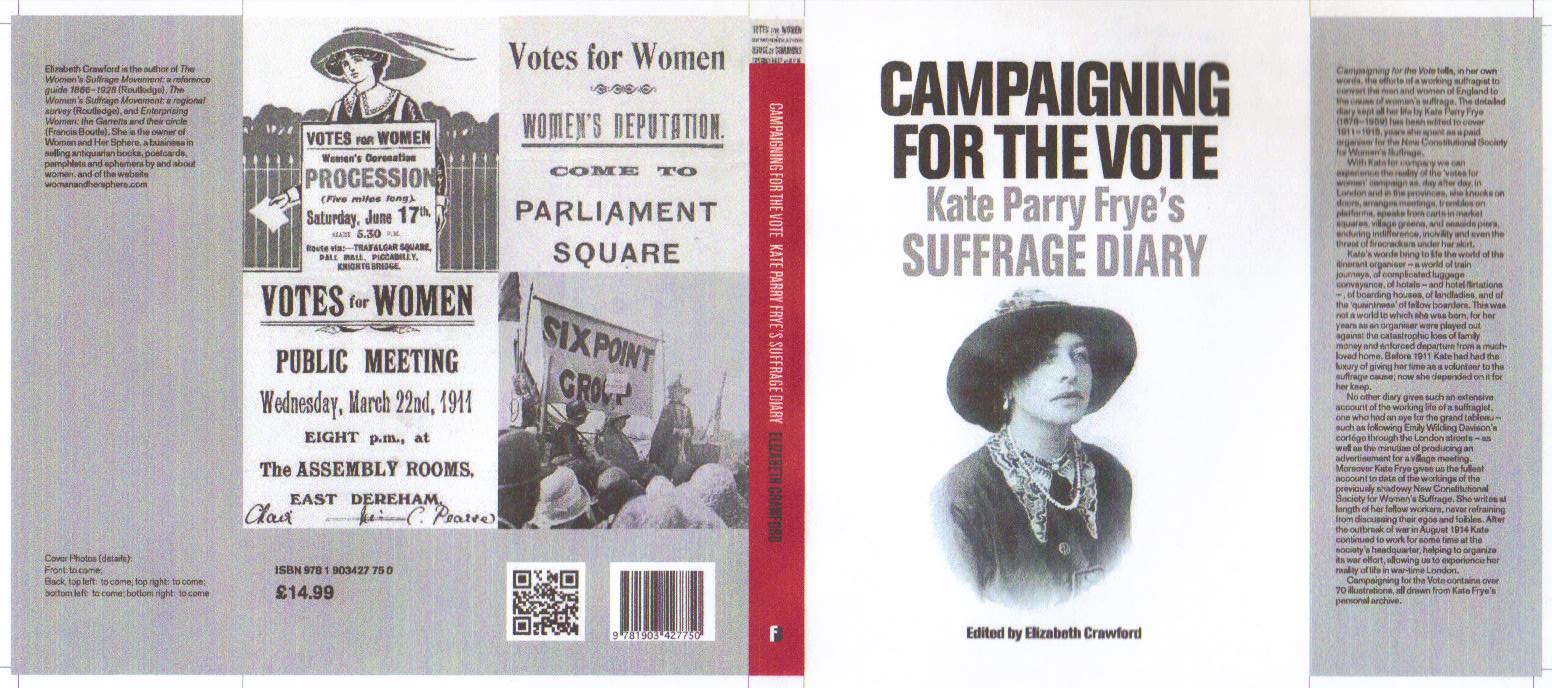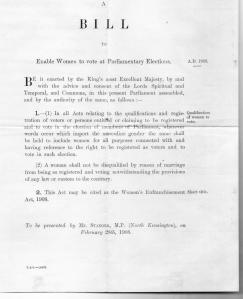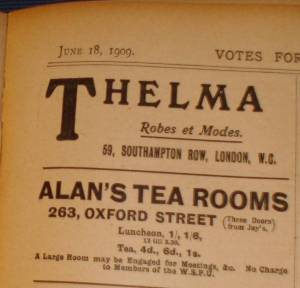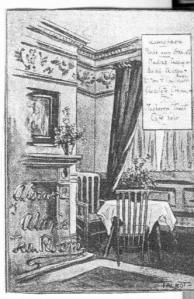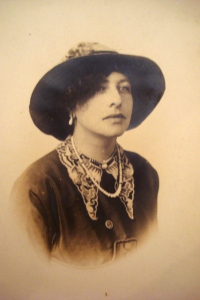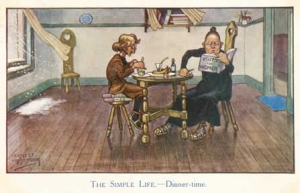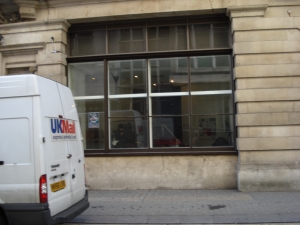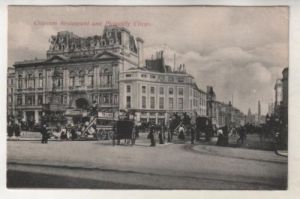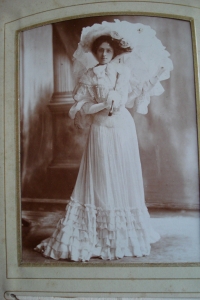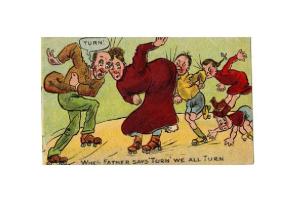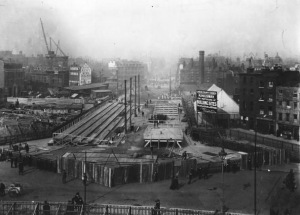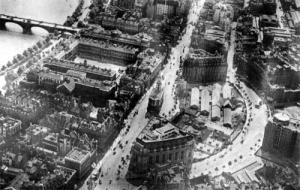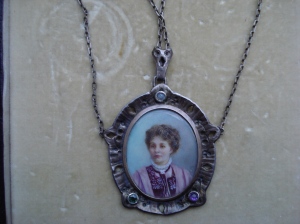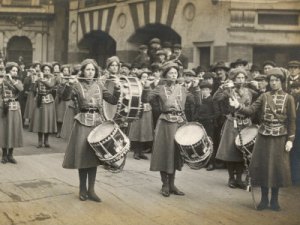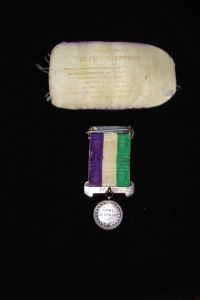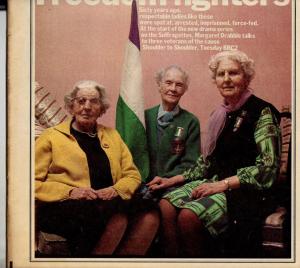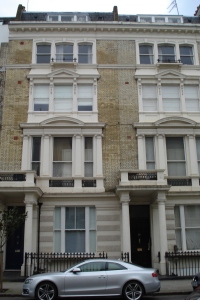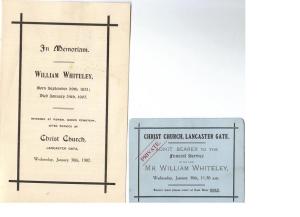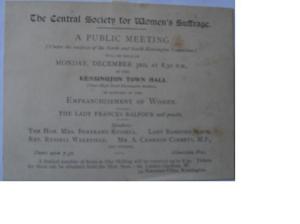Posts Tagged suffragette
Collecting Suffrage: Fake Flags – Or Why Researching Material Culture Matters
Posted by womanandhersphere in Collecting Suffrage on June 19, 2023
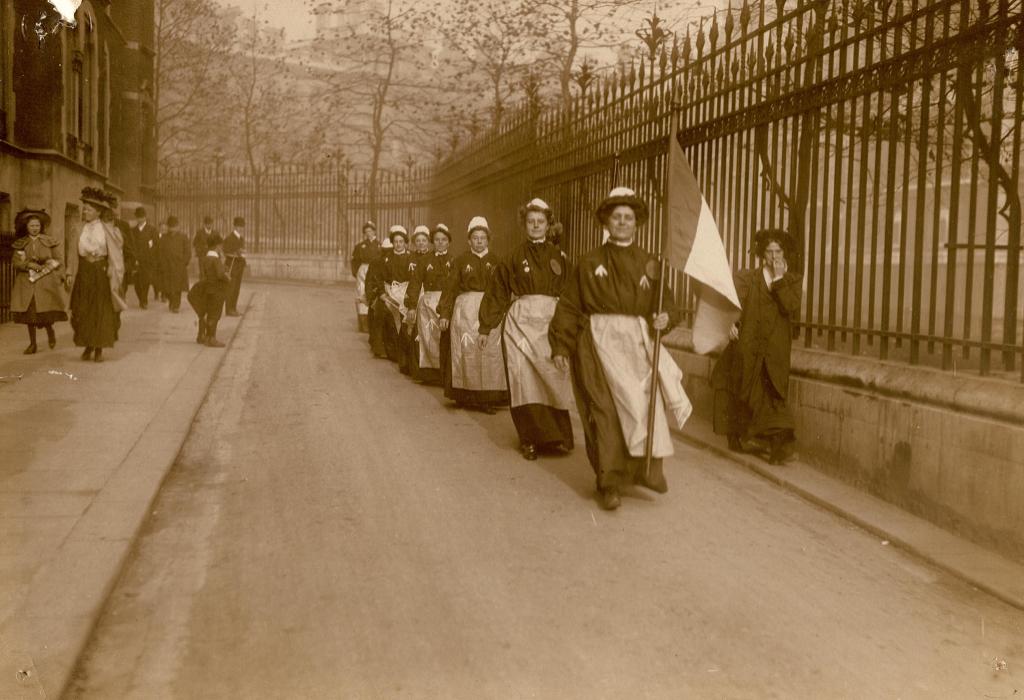
Led by Miss Kerr, who is carrying a WSPU flag, suffragettes parade outside the WSPU offices in Clement’s Inn (image courtesy of Women’s Library@LSE)
When I started in business nearly 40 years ago as a dealer in books and ephemera, specialising in the lives of women, there was little need to think twice about the authenticity of any appealing object. I do remember being very careful to check that a signature on, say, a photograph of Mrs Pankhurst was penned rather than printed but, in those days, ‘women’ as a class had not attracted the attention of scammers. How times have changed. And that change is particularly manifest in objects associated with the suffragette movement.
Nowadays I take extreme care, perhaps bordering on paranoia, to check the authenticity and provenance of any object before I add it to stock. For unscrupulous dealers are now ridiculing the suffragette movement by creating and selling objects that claim to be associated with the WSPU. Perhaps, unsurprisingly, the NUWSS has not attracted this attention, scammers knowing where lies the popular appeal.
This trade disturbs me on several levels. I am upset to see those with no knowledge or interest in the suffrage movement traducing the historical record, I am upset to see buyers disappointed when, thinking they have acquired an original object, they discover they have not, and I am particularly worried when, as has happened, a public collection acquires a spurious suffrage artefact.
It may be useful to present the history of one element of suffragette material culture that currently concerns me: the phenomenon of the WSPU flag currently flooding the market.
It was probably three or four years ago that a purple, white, and green flag first appeared on an eBay site. Along the white side selvedge strip was printed the legend ‘WPSU 3 & 4 Clement’s Inn, Strand W.C.’. I have not kept a record of the price this object fetched, but it was, if memory serves, several hundred pounds. Another book dealer contacted the seller to point out that this flag was unlikely to be original, as the initials were incorrect – ie ‘WPSU’ rather than ‘WSPU’. He did not receive a reply, but answer was made in kind as another flag then appeared – with the middle two letters cut out – leaving only the ‘W’ and the ‘U’ – and the (correct) address. Laughable, really. In fact, at the moment (June 2023) one of these flags is available for sale on eBay – for £260 – although now the whole of ‘WPSU’ has been raggedly removed, leaving only the address.
Most of the flags now boast a ‘Votes for Women’ slogan across the central white stripe and have a variety of marks on the white webbing at the side. Currently (June 2023) there are 7 WSPU flags for sale on eBay: one is marked with ‘1912’, two with ‘London 1908’, one with ‘London 1910’, and two with ‘1910 WSPU’ (both of these listed by the same dealer). The flags are priced at between £149 and £895.
Between March and June 2023 27 ‘original’ WSPU flags were sold on eBay– their prices ranging from £58 to £310. Again, they are printed on the selvedge with dates and places – such as ‘Bath 1912’, ‘London 1914’ etc. They variously claim to have been found in ‘a box at an antiques fair’ or from ‘a deceased estate’.
A number of these flags have moved from eBay to terrestrial auctions and, on the whole, auctioneers do remove them from a sale once doubts are expressed as to their originality. I note that one auctioneer who initially refused to withdraw one of the flags from sale – and has since sold several more – does at least now note that their authenticity cannot be guaranteed. The flags have, of course, moved out of salerooms and are now to be found at antiques markets and fairs and I accept that, as they move further from their source, vendors may well not realise that they are selling fakes.
I have not inspected any of these flags in person – my reasons for knowing that they are not ‘right’ is based on my many years of archival research and on my hard-acquired knowledge of the trade in suffrage ephemera. At the most basic level, if you study the Flickr account of the Women’s Library@LSE, perhaps the most extensive photographic record of the suffrage movement available to view on the internet, you will note that there is no evidence of the WSPU flag as is currently being traded. At the head of this post is one of the few photographs to show a WSPU flag (we presume it is purple, white, and green but, of course, the photograph is in black and white). However, you will note that the orientation of the stripes is such that one of the colours (purple or green?) lies against the carrying pole, whereas on that of the fake flag all the colours meet the pole. That is to say, the stripes on the flags currently being sold are lying horizontally, whereas they should be positioned vertically. In addition, I do not remember seeing a ‘Votes for Women’ slogan imposed on a purple, white and green flag; they are invariably plain. I suspect that any analysis of the material and method of manufacture would indicate a 21st rather than early-20th century provenance.
The Women’s Library photographs do, of course, contain innumerable images of all manner of other banners and it was exactly because I am always so worried about fakery that when, in 2017, I spotted an amazing Manchester banner coming up for sale at a little-known auction house, I alerted first the Working Class Library and, through their archivist, the People’s History Museum because I thought it essential for a textile expert to inspect it in person in case somebody had taken it upon themselves to fake it. Fortunately, it was ‘right’ and now hangs in pride of place in the PHM.
The Manchester WSPU banner (image courtesy of the People’s History Museum)
And that is why I hope that no well-meaning donor will think of presenting their local museum with one of the spurious ‘Votes for Women’ flags for, by allowing the scammers to muscle in on our history, we are demeaning everything that is ‘right’.
Cynic that I am in such matters, I only hope this post does not encourage scammers to create more accurate reproductions.
Copyright
All the articles on Woman and Her Sphere are my copyright. An article may not be reproduced in any medium without my permission and full acknowledgement. You are welcome to cite or quote from an article provided you give full acknowledgement
For International Women’s Day: ‘Shout, Shout, Up with your Song’
Posted by womanandhersphere in Books And Ephemera For Sale on March 8, 2023
A few rousing items for sale to mark International Women’s Day 2023
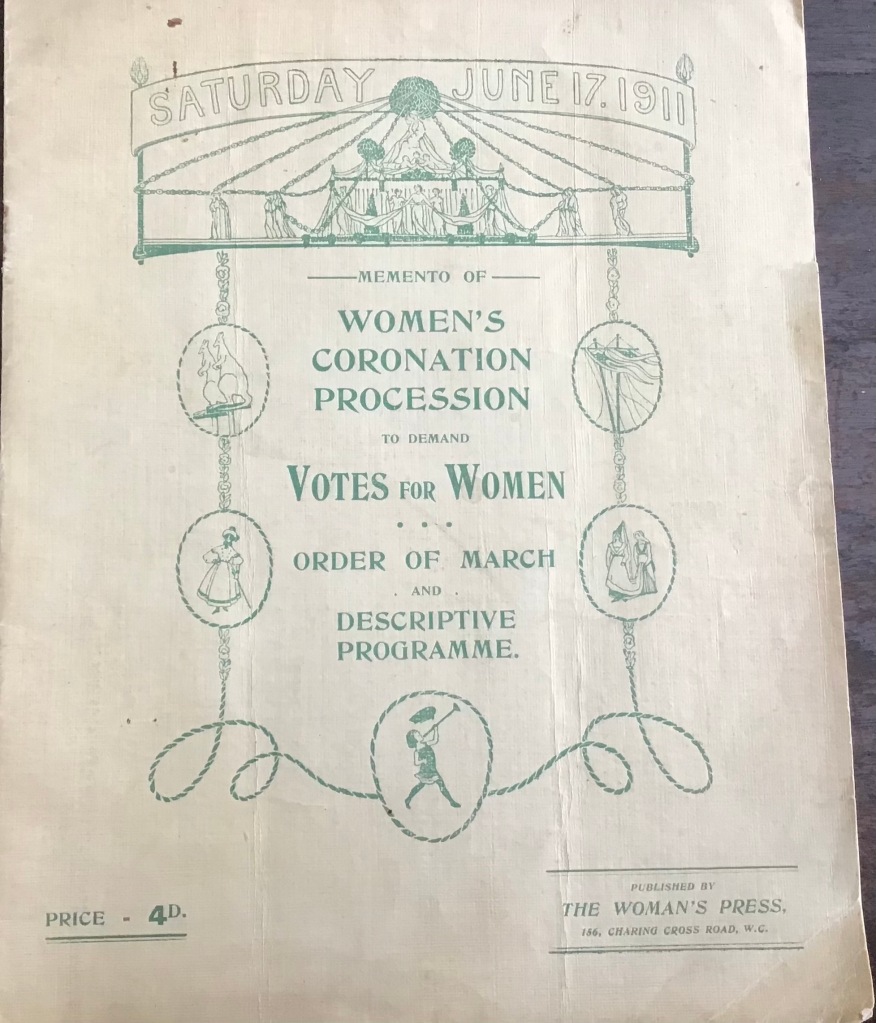
- MEMENTO OF WOMEN’S CORONATION PROCESSION TO DEMAND VOTES FOR WOMEN: Order of March and Descriptive Programme The Women’s Press 1911
This is the official programme for the spectacular march that was held in London on Saturday June 17 1911. ‘From the Introduction: ‘The March through London of 40,000 women has been arranged to show the strength of the deman to win Votes for Women in Coronaton year. The Procession will form up on Westminster Embankment, starting at 5.30pm and marching seven abreast in a line some five miles long, through Trafalgar Square, Pall Mall, Piccadilly, Knightsbridge, to Kensington. At the close of the march a great meeting will be held by the Women’s Social and Political Union in the Albert Hall…’ The programme lists all the suffrage societies taking part and describes in detail the different sections – such as the Prisoners’ Pageant and the Historical Pageant. The ‘Order of March’ is inset. The decorative cover is printed in greeen on good quality thick paper, In good condition – with a little rusting at the staples- a very scarce item.
[15320] £700
2. THAT RAGTIME SUFFRAGETTE SHEET MUSIC B. Feldman & Co c 1913
written by Harry Williams and Nat D. Ayer and originally heard in the 1913 Ziegfeld Follies. It was recorded c 1913/14 by Warwick Green – a British comic singer – to very great effect, although I think he omits the second verse, which is printed in this sheet music. You can hear Warwick Green singing ‘That Ragtime Suffragette’ on youtube. I think it’s wonderful – so evocative- ‘Ragging with bombshells and ragging with bricks/ Hagging and nagging in politics’. The 4-pp of sheet music is printed ‘Professional Copy’ – in good condition, a little rubbed and scuffed; I’m sure it has been well played. Very scarce.
[15319] £120
3. THE MARCH OF THE WOMEN
‘Dedicated to the Women’s Social and Political Union’ by its composer, Ethel Smyth. This is an example of the ‘Popular Edition in F. (For meetings and processions, to be sung in unison)’. The 4-page song sheet, containing both music and the words, the latter written by Cicely Hamilton, was published by Breitkopf & Hartel of 54 Great Marlborough Stree, London W and was ‘To be had of The Woman’s Press, 156 Charing Cross Road, London, W.C.’ Price Threepence. ‘The March of the Women’ was premiered at a WSPU meeting, held on 21 Jan 1911 to celebrate the release from prison of WSPU militants. The back cover lists ‘Works by Ethel Smyth, Mus. Doc.’. The song-sheet has been folded and is a little rubbed and marked, having presumably been put to its intended use at some WSPU rally, but is in generally good condition. Very scarce £250
4. ‘THE WOMEN’S MARSEILLAISE’
Written by Florence Macaulay (1862-1945), one-time student at Somerville College, Oxford, and an organiser for the WSPU. ‘The Women’s Marseillaise’, a marching song, was written in 1909 and begins ‘Arise, ye daughters of a land/That vaunts its liberty’. This single sheet is headed ‘The National Women’s Social & Political Union 4 Clement’s Inn, Strand, W.C.’ and was printed by ‘Geo. Barber,The Furnival Press, E.C.’ The sheet was clearly used for the purpose intended, has been folded, with a slight split at the edges of the fold. In good condition – very scarce
[15314] £120
5. ‘VOTES FOR WOMEN’ to be sung to the tune of ‘Bonnie Dundee’
Songsheet, – the words of a song adapted from a poem by Sir Walter Scott, to be sung to the tune of ‘Bonnie Dundee’. It begins ‘To the Lords of Westminster ’twas the suffragette spoke:-/Put us in the King’s Speech, and give us the Vote,/Let each mother’s son who loves freedom to see,/Cry ‘Votes for the Women’ let Britons be free!’. No publisher or society is credited as issuing of the songsheet, which was in circulation by April 1908.(because Campbell-Bannerman is cited, still prime minister). So quite an early example of a suffrage songsheet. Good -single sheet – some foxing
[15309] £120
6. WOMEN’S SOCIAL AND POLITICAL UNION ‘VOTES FOR WOMEN’ LEAFLET NO. 61
This double-sided leaflet is devoted to publishing Laurence Housman’s ditty ‘Woman This, and Woman That’, an ‘Echo of a ‘Barrack-room Ballad, with acknowledgments to Mr Rudyard Kipling’. It begins ‘We went up to Saint Stephens, with petitions year by year;/’Get out!’ the politicians cried, ‘we want no women here!’/ and was avery popular party-piece at WSPU gatherings. Perhaps its most famous rendition was by actress Decima Moore on the night of the 1911 census, when her audience comprised c 500 suffragettes evading the enumerator in the Aldwych Skating Rink. This leaflet is headed with full details of the WSPU office and leading personnel and was printed by the St Clement’s Press, Portugal Street (now the site of the LSE Library). Like many such ephemeral pieces, it has been folded – presumably in use at a WSPU gathering – with a slight split along a fold – but no loss of text. Although fragile, it is actually in quite good condition, considering its age and purpose
[15317] £150
**
If interested in buying any of these ephemeral items – do email me – elizabeth.crawford2017@outlook.com . You can pay me by bank transfer (preferred method), cheque or (if from overseas) at www.Paypal.com, using my email address as the payee account.
**
Collecting Suffrage: Suffragette Fakery
Posted by womanandhersphere in Collecting Suffrage on December 2, 2021
Over the years I have expressed concern about the practice of dealers and auctioneers in labelling as ‘suffragette’ any piece of jewellery that combines stones approximating to suffragette colours of purple, white and green. I explained in another post [see https://wp.me/p2AEiO-nd] that such jewellery would have had no association with the suffragette movement, the colours were merely harmonious and fashionable, which was why they had been chosen by the Women’s Social and Political Union as their ‘brand’. This practice is, I am afraid, still rife, but at least I have tried to warn the trade and the public.
However, I am now increasingly worried by the number of deliberately faked suffragette objects that are being sold both on eBay and by British auction houses, often for high prices. Fake ‘suffragette’ flags, watches, cigarette cases, car badges, defaced coins, and woven cloth badges are the latest items to appear in auction house sales. Having specialised in suffrage ephemera – as an historian and a dealer – for over 35 years I can assure my readers that most of these objects either never existed in the ‘suffrage’ years and are being dreamed up – and manufactured – by unscrupulous sellers, or are modern copies. I do occasionally protest to terrestrial auction houses about individual items and they then invariably withdraw them from sale – but I cannot hope to stem the tide alone.
While I hate the idea of private buyers being duped, not only by spending large sums but also by thinking, erroneously, that they own an artefact with a real connection to the suffrage movement, my principal fear is that such objects will end up in public collections; indeed, I know this to have happened. If the institution is made aware of its mistake and removes the object from display, it has lost money; if the object passes into the collection unchallenged, it is legitimising a fiction. I would ask potential buyers to think carefully – and even consult an expert – before spending money on artefacts labelled as ‘suffragette’. Better still, research the movement carefully so that you can exercise your own judgment. There are still plenty of ‘right’ objects to be found but, as ever, this maxim holds: ‘If an item looks too good to be true, it probably is’.
Caveat Emptor
To see something of the marvellous range of suffrage artefacts that were actually produced by suffrage societies do consult Ken Florey’s site. Although treating, in the main, items produced to publicise the US suffrage movement, he also includes a wide range of British items.
My website also includes a number of articles that may prove useful – under the ‘Collecting Suffrage’ heading. And, if you would like advice about an item you are thinking of buying, you can always ask for my opinion.
Lockdown Research: Stella Spencer, Suffragette: From Holloway To Montevideo
Posted by womanandhersphere in Lock-Down Research on December 1, 2020
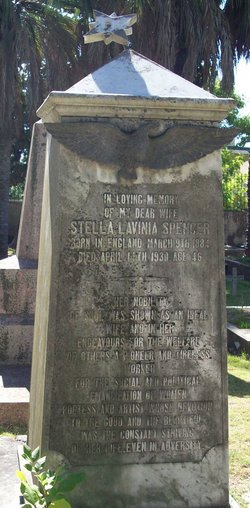
(photo courtesy David Rennie)
The epitaph reads:
In Loving Memory of my dear wife STELLA LAVINIA SPENCER born in England March 9th 1884 died April 14th 1930 age 46. Her nobility of soul was shown as an an ideal wife and in her endeavours for the welfare of others. A pioneer and tireless worker for the social and political emancipation of women. Poetess and artist whose devotion to the good and the beautiful was the constant striving of her life. Even in adversity.
I recently had an enquiry, emanating from Uruguay, as to whether I knew of Stella Lavinia Spencer, who had died in Montevideo in 1930, was buried in the city’s British Cemetery, and had, perhaps, been a suffragette. Well, the short answer was ‘No’ – the name rang no bells – but a quick search showed that a Stella Lavinia Spencer was indeed listed in the Roll of Honour compiled by the Suffragette Fellowship. So the hare was ready to be chased.
Identifying her as a possible suffragette was the easy bit. The attempt to untangle the identity of Stella Lavinia Spencer has been a good deal more complicated. No-one of that name appears in the list of ‘Suffragettes Arrested’ compiled by the Home Office, nor does she appear on any census. It is obvious from the wording on the tombstone that ‘Spencer’ was her married name and the Probate Register revealed that her husband’s name was ‘Alberto John Spencer’. So the hunt was on to establish her maiden name.
One would have thought that, with the relatively unusual forenames of ‘Stella Lavinia’ and a firm birth date of 1884, this wouldn’t be difficult. But, in fact, no-one of those names appears to have been born in England (or anywhere else) in 1884. Was she perhaps a child registered before her parents had selected her name? It’s possible. Or could she have refashioned herself, selecting names more appealing than those with which she had been furnished by her parents? Again, a possibility. There’s probably a quite straightforward reason for her absence from the various registers, civil or ecclesiastical, but, if so, I haven’t found it.
However, thanks to a general Google search for ‘Stella Lavinia Spencer’ I encountered an article (‘You Are Not a White Woman’) by James Heartfield (The Journal of Pacific History, vol 38, no 1, 2003) which sketched something of my quarry’s biography – as well as telling a rather riveting story. The article concerns the trial in Fiji in 1915 of Stella Spencer, which makes clear that she was by now married. But it turns out that ‘Spencer’ was not her husband’s family name; ‘Alberto John Spencer’ was originally ‘Alberto John Sangorski’. This was a surname I knew very well, as Sangorski and Sutcliffe was the leading firm of ‘art’ bookbinders in England at the beginning of the 20th century. Research quickly revealed that Stella’s husband, Alberto Spencer, was the son of Alberto Sangorski, renowned as the firm’s illuminator and calligrapher.
Anyway, armed with this new knowledge, I was now able to search for the marriage of Alberto Sangorski and, sure enough, found that he had married in Kensington in the summer of 1910. But even now matters were complicated by a quirk in the listing on the register that didn’t make clear the name of his bride. I won’t bore you with the ramifications of my further searches but only say that I finally decided that a likely candidate was a ‘Stella L. Mahny’. Needless to say I could find no other record of a woman with that rather unlikely surname, but with this faint lead I returned to the ‘Suffragettes Arrested’ register and discovered that a ‘Stella O’Mahoney’ had been tried in Westminster on 1 July 1908. Without the tedious unravelling of the link to the Spencer surname I could not have been certain that I had the right ‘Stella’. But I am sure now that I have.
And what was it that she had done to merit arrest? Votes for Women (9 July 1908) reported that, on 30 June 1908, Miss Stella O’Mahoney had taken part in a demonstration organised by the Women’s Social and Political Union in the vicinity of the House of Commons and that, with 26 other WSPU members, had been arrested. She was ordered to give a surety of £20 not to take part in any other militant activity, but refused, and was instead sentenced to a month’s imprisonment in Holloway. At the trial she gave her address as that of the WSPU office, 4 Clement’s Inn, so, once again, I could get no closer to her.
There is no other record I can find of Stella O’Mahoney’s involvement with the WSPU but I would presume that she had been a member both before and after this incident. However, a couple of years later, soon after her marriage, she and Alberto set off for Australia, landing in Sydney on 17 November 1910.
The Heartfield article mentions that Stella Spencer had worked as a journalist, but I have been unable to find any articles written by her. The tombstone describes her as a poet and an artist, but, yet again, I can find no trace of her work in any medium.
So, Stella Spencer would remain something of an enigma were it not for the reasons behind her trial in Fiji in March 1915 that James Heartfield reveals in his article. She had arrived with her husband from Melbourne about seven months earlier because he had been employed in a new venture, the Fiji Produce Agency. This organisation had been set up as a means for Fijians to market their own produce, in competition with European traders. The background rivalry, both economic and political, was complicated, but the upshot was that Stella Spencer stood trial, accused of slapping a Fijian in the face. He was a henchman of the European faction and had accused her of being ‘a bad woman’, the implication being that she was sexually involved with a Fijian. The ensuing trial – of a white woman accused of assaulting a Fijian – was remarkable, motivated not from a desire to protect Fijians, but to punish those Europeans who failed to observe the policy of separation from the indigenous population.
Stella Spencer was found guilty but apparently, Heartfield reports, did not have sufficient funds to pay the fine levied and was, therefore, imprisoned. I have no evidence whatsoever for querying this, but did just wonder if, as in 1908, it was rather that she had refused to pay a fine. It seems very surprising that no funds could be mustered if she had been minded to pay. Stella then went on hunger strike, perhaps in emulation of the suffragette stratagem, adopted subsequent to her 1908 imprisonment. However, she abandoned the hunger strike after four days and wrote to the governor asking for passage to Melbourne for herself and her husband. This was granted at the end of April 1915. I don’t know when and why she and Alberto eventually made their home in Montevideo but he remained there for the rest of his life, dying in 1954, twenty years after Stella, and is buried in the same cemetery.
It is not difficult to detect a parallel between Stella Spencer’s interest in the emancipation of women and that of improving the lot of the native population of Fiji. Whatever her background, she was clearly imbued with a spirit of rebellion
Copyright
All the articles on Woman and Her Sphere are my copyright. An article may not be reproduced in any medium without my permission and full acknowledgement. You are welcome to cite or quote from an article provided you give full acknowledgement
Collecting Suffrage: Gladice Keevil Photographed by Lena Connell
Posted by womanandhersphere in Collecting Suffrage on September 21, 2020
Portrait photograph of Miss Gladice Keevil, The ‘National Women’s Social and Political Union, 4 Clement’s Inn, WC’.
The photographer was Lena Connell, who, in an interview in the Women’s Freedom League paper, The Vote, dated her involvement with the suffrage movement to this commission. When she arrived at Lena Connell’s St John’s Wood studio in 1908 Gladice Keevil had not long been released from prison and was soon appointed National Organizer for the WSPU in the Midlands.
She was a speaker in the WSPU’s summer campaign in Ireland in 1910 and was described by a member of one of her open-air meetings in Belfast as ‘Clever speaker and knows her subject’. She was also one of the WSPU’s prettiest activists.
Postcard in fine condition – unposted £120 + VAT in UK and EU. Email me if interested in buying. elizabeth.crawford2017@outlook.com
Collecting Suffrage: Questions To Lloyd George Asked By The Women’s Social And Political Union
Posted by womanandhersphere in Collecting Suffrage on August 26, 2020
A leaflet on which the WSPU set out eleven questions concerning Lloyd George’s behaviour in introducing a Government measure for Manhood Suffrage in 1913.
Among the many other pertinent questions: ‘Why do you expect us to accept your personal and unofficial advocacy of Woman Suffrage as a substitute for united and official action on the part of the Government as a whole?
Two-sided leaflet, printed in purple. In good condition – some creasing. £100
If interested in buying – email me – elizabeth.crawford2017@outlook.com
Collecting Suffrage: ‘Votes For Women’ Hooks And Eyes
Posted by womanandhersphere in Collecting Suffrage on January 16, 2015
In over 30 years spent hunting for and selling objects related to the women’s suffrage campaign, this little box is the only example I have ever found of ‘Votes for Women’ Hooks and Eyes. Although I had it photographed in black and white back in the 1990s, the box in reality is tricked out in the WSPU colours of purple, white and green.
The manufacturer registering ‘Votes for Women’ as its trademark was not the only maker of hooks and eyes to discern a market for its goods among the supporters of the suffrage cause. Votes for Women (eg issue for 23 April 1909, p 26) carried advertisements for ‘Smart’s invisible hooks and eyes ‘ which were the’ patented invention and property of two members and supporters of the Women’s Social and Political Union.’
These items might well have been found amongst the stock of the suffrage shops opened by the various suffrage societies.
As well as being campaigners, the majority of suffragettes and suffragists were, of necessity, also needlewomen. So here was an opportunity to back the Cause while sewing fastenings onto their skirt plackets or bodices.
Copyright
Kate Frye’s Suffrage Diary: Palmist At The Women’s Freedom League Bazaar
Posted by womanandhersphere in Kate Frye's suffrage diary on December 10, 2012
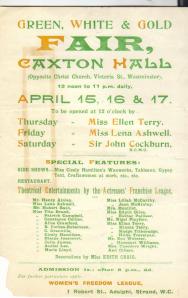 By 1909 Kate Frye was keenly involved – as a volunteer – in the women’s suffrage campaign. Although she belonged to the constitutional London Society for Women’s Suffrage she was happy to give her services to other, more militant, suffrage societies – such as the Women’s Freedom League.
By 1909 Kate Frye was keenly involved – as a volunteer – in the women’s suffrage campaign. Although she belonged to the constitutional London Society for Women’s Suffrage she was happy to give her services to other, more militant, suffrage societies – such as the Women’s Freedom League.
Dramatis Personae for these entries
Marie Lawson (1881-1975) was a leading member of the WFL. An effective businesswoman, in 1909 she formed the Minerva Publishing Co. to produce the WFL’s weekly paper, The Vote.
May Whitty (1865-1948) and Ben Webster (1864-1947) were a well-established theatrical couple. Kate had toured with May Whitty in a production of J.M. Barrie’s Quality Street in 1903.
Ellen Terry (1847-1928) the leading Shakesperean actress of her age.
Edith Craig (1869-1947) theatre director, producer, costume designer, and a very active member of the Actresses’ Franchise League. She staged a number of spectacles for suffrage societies, working particularly closely with the Suffrage Atelier and the Women’s Freedom League. In January 1912 Kate appeared in Edith Craig’s production of The Coronation.
Lena Ashwell (1862-1957) actress, manager of the Kingsway Theatre, a vice-president of the Actresses’ Franchise League and a tax resister.
Thursday April 15th 1909 [The Plat, Bourne End]
I went up to London at 9.50 all in my best. Went to Smiths to leave the books – then straight from Praed St to St James Park by train and to the Caxton Hall for the 1st day of the Women’s Freedom League Bazaar. Got there about 11.30 – everything in an uproar, of course. I had to find out who was in authority over me and where I was to go to do my Palmistry. I had to find a Miss Marie Lawson first and then was taken to a lady who had charge of my department and she arranged where I was to go. A most miserable place it seemed – in a gallery overlooking the refreshment room. I meant to have gone out to have a meal first – but it all took me so long running about getting an extra chair etc that I should have missed the opening. Then another Palmist hurried up – the real thing who donned a red robe. I was jealous. Madame Yenda.
We got on very well, however, and exchanged cards (I have had some printed) it was all about as funny as anything I have ever done and I have had some experiences.
Then I went back to the main room which was beginning to get thronged and stifling from the smell of flash- light photographs. I discovered Miss May Whitty and Mr Ben Webster and chatted to them while we waited for Miss Ellen Terry who was half an hour late. Miss Whitty was awfully nice and I quite enjoyed meeting her again. Ellen Terry looked glorious in 15th century costume and was very gay and larkish. Her daughter Edith Craig was there to look after and prompt her – and ‘mother’ her – what a mother to have had. I expect she had to pay for it. She is a sweet-looking woman with a most clever face – only a tiny shade of her Mother in it but Ellen Terry took the shine out of everyone – what a face to be sure. When she went round the stalls I went to the Balcony and for a little time Madame Yenda and I tried to work up there together but it was impossible. All my clients had to disturb her as they walked to and fro so at last I came out to find 3 more Palmists waiting and nowhere for them to work. One, a real professional, was very cross especially at the small fee being charged and I don’t think she could have been there long. Two other girls, looking real amateurs, were also there. So I sat a while at a table outside and told a few but it wasn’t very satisfactory and at 2 o’clock I went out for some lunch leaving the four others there. I went into a Lyons place in Victoria Street and then went back a little before 3 o’clock meaning to have a look round the Bazaar but I was pounced on to begin again and I was alone at it all the afternoon from 3 till 5.45 up in the gallery. I was left at it with sometimes just a few minutes in between but must have told 40 hands I should say. I did about 7 or 8 before 2 o’clock. We were only supposed to give 10 minutes at the outside but I could not quite limit myself and sometimes, when there wasn’t a rush, I had long talks with the people. It was very interesting and on the whole I think I was successful. Train to Praed St and to Smiths for the books and home by the 6.45.
Friday April 16th 1909 [The Plat, Bourne End]
I went straight to Caxton Hall by train from Praed St to St James’s Park – left some flowers at the flower stall. Mother had packed up some lovely bunches for me. Then I went up to the l[ondon] S[ociety] for W[omen’s] S[uffrage] office on business connected with the Demonstration – then back to the Caxton Hall for the opening of the Green White and Gold Fair on the second day. Miss Lena Ashwell was punctual 12 o’clock and she looked delicious and did it all so nicely. Madame Yenda was there but no other Palmists. My chatty friend, who greeted me rapturously, helped fix up the gallery a much nicer place – but clients did not come very early -they were all following Lena Ashwell – so I had 1/- from Madame Yenda myself. I think she was clever but, of course, I am rather a hard critic at it. She told me a great many things I know to be absolutely true and she gave me some good advice especially about morbid introspective thoughts and I think she is quite right. I do over worry. I am to beware of scandal which is all round me just now. She predicts a broken engagement, a rich alliance and always heaps of money. I should have immense artistic success in my profession if only I had more confidence in myself and if only I had some favourable influence (a sort of back patter, I take it) to help me but such an influence is far away. I shall never live a calm uneventful existence. I shall always spend so much of myself with and for others. I am rather glad of that. I was just beginning to tell her her hand but I wouldn’t let her pay as she told me she was very poor and I could see it when some clients came for us both and we both had to start our work.
I didn’t feel a bit inclined for work at first but got into it and had wonderful success. Kept on till 2 o’clock – went to the Army and Navy Stores then and had some fish for lunch – then back – saw the ‘Prison Cell’ for 5 and was very interested – then started work at 2.45 and never moved off my chair till 6.15. I did have an afternoon of it. Madame Yenda had gone and I was alone in my glory. I must have had quite another 40 people if not more and they were waiting in line to come in to me. I seem to delight some of the people and one or two said I quite made them believe in Palmistry. One old lady came back for another shill’oth [shilling’s worth] as I had been so good with her past and present she wanted her future. I must have been very clairvoyant as I told the people extraordinary things sometimes and they said I was ‘true’. Of course one or two I could not make much headway with but that must always be so.
Where I found I had missed my train I wanted to go on but my chatty friend was really awfully decent and would not hear of it. She said if I would tell one man who had been waiting ever so long that was all I must do and she would send the others away. There were about 18 waiting and she did – rather to my relief. I felt ‘done’
Campaigning for the Vote: Kate Parry Frye’s Suffrage Diary edited by Elizabeth Crawford
For a full description of the book click here
Wrap-around paper covers, 226 pp, over 70 illustrations, all drawn from Kate Frye’s personal archive.
ISBN 978 1903427 75 0
NOW, ALAS, OUT OF PRINT.
KATE FRYE’S DIARIES AND ASSOCIATED PAPERS ARE NOW HELD BY ROYAL HOLLOWA COLLEGE ARCHIVE
You can listen here to a talk I gave in the House of Commons – ‘Campaigning for the Vote: From MP’s Daughter to Suffrage Organiser: the diary of Kate Parry Frye’.
Copyright
Kate Frye’s Suffrage Diary: The Mud March, 9 February 1907
Posted by womanandhersphere in Kate Frye's suffrage diary on November 21, 2012
Kate Frye had first joined a suffrage society in the spring of 1906. Her choice was the Central Society for Women’s Suffrage (later renamed the London Society for Women’s Suffrage) – a constituent society of the National Union of Women’s Suffrage Societies Interest in the long-running women’s suffrage campaign leapt ahead in the following few months and in February 1907 the NUWSS staged the first open-air suffrage spectacular – a march through the wintry, muddy London streets. For obvious reasons this became known as the ‘Mud March’. Kate’s estimate of 3000 participants accords with later reports.
Saturday 9 February 1907 [25 Arundel Gardens, North Kensington]
 In bed for breakfast – and what was my utter disgust – and disappointment – to hear the torrents of rain – and there was not a shadow of its coming last night – it was bitterly cold. As it was so heavy I hoped it would stop – but it went on and on into a fine heavy drizzle. They said I should be mad to go in the procession and though I knew I must – I went out at 12.30 taking Mickie a walk and sent a telegram to Alexandra Wright telling her the rain prevented my joining them. I had arranged to be at their house at 1 o’clock and go with them to Hyde Park. We all had lunch. I knew I was going all the time – but couldn’t go. Off to wash my hands. 2 o’clock. ‘They will be just starting’, said I. Then as I washed I made up my mind I would go rain or no rain and – lo – the rain had ceased. I prepared a plan to Agnes. She too knew she was to be of it – both flew upstairs and were out of the house before 2.15.
In bed for breakfast – and what was my utter disgust – and disappointment – to hear the torrents of rain – and there was not a shadow of its coming last night – it was bitterly cold. As it was so heavy I hoped it would stop – but it went on and on into a fine heavy drizzle. They said I should be mad to go in the procession and though I knew I must – I went out at 12.30 taking Mickie a walk and sent a telegram to Alexandra Wright telling her the rain prevented my joining them. I had arranged to be at their house at 1 o’clock and go with them to Hyde Park. We all had lunch. I knew I was going all the time – but couldn’t go. Off to wash my hands. 2 o’clock. ‘They will be just starting’, said I. Then as I washed I made up my mind I would go rain or no rain and – lo – the rain had ceased. I prepared a plan to Agnes. She too knew she was to be of it – both flew upstairs and were out of the house before 2.15.
We tore to Notting Hill Gate – meaning to go the quickest way. No motor bus – so we tore for the train – it came in as I started to race down. In we scrambled – had to change at South Kensington much to our disgust – but we were not kept long. We flew out at Charing Cross and up Villiers Street. No sign of the Procession of Women Suffragists in the Strand. They were timed to leave Hyde Park at 2 o’clock so I had to pluck up my courage and ask a policeman. No, they had not passed. So, knowing the route, we flew up as far as Piccadilly Circus and there in about 2 minutes we heard strains of a band and waited, anxious and expectant. The crowd began to gather and we were nearly swept away by the first part – a swarm of roughs with the band – but the procession itself came – passed along dignified and really impressive. It was a sight I wouldn’t have missed for anything – and I was glad to have the opportunity of seeing it as well as taking part in it.
 We stood right in front so as not to miss our contingent – and I asked if they knew where it was. Miss Gore Booth said it was coming and we were fearfully excited and I was so anxious not to miss our lot. I shrieked out when I saw Miss Doake’s red head in the distance and we dashed up to them and asked if we could join in. Alexandra carried our banner. Mrs Wright said come along here – it felt like boarding an express train but I suppose it was a quite simple rally though I cannot look back on it as that – but we were so excited and so anxious not to miss them. We walked three abreast – Miss Doake, Agnes and I – I was on the kerb side – behind us Gladys [Wright], Miss Ellis and Mrs Doake. North Kensington was not very well represented but I really do not know who else of us was there.
We stood right in front so as not to miss our contingent – and I asked if they knew where it was. Miss Gore Booth said it was coming and we were fearfully excited and I was so anxious not to miss our lot. I shrieked out when I saw Miss Doake’s red head in the distance and we dashed up to them and asked if we could join in. Alexandra carried our banner. Mrs Wright said come along here – it felt like boarding an express train but I suppose it was a quite simple rally though I cannot look back on it as that – but we were so excited and so anxious not to miss them. We walked three abreast – Miss Doake, Agnes and I – I was on the kerb side – behind us Gladys [Wright], Miss Ellis and Mrs Doake. North Kensington was not very well represented but I really do not know who else of us was there.
Then the real excitement started. The crowds to see us – the man in the street – the men in the Clubs, the people standing outside the Carlton – interested – surprised for the most part – not much joking at our expense and no roughness. The policemen were splendid and all the traffic was stopped our way. We were an imposing spectacle all with badges – each section under its own banners. Ours got broken, poor thing, unfortunately, and caused remarks. I felt like a martyr of old and walked proudly along. I would not jest with the crowd – though we had some jokes with ourselves. It did seem an extraordinary walk and it took some time as we went very slowly occasionally when we got congested – but we went in one long unbroken procession. There were 3000 about I believe. At the end came ever so many carriages and motor cars – but of course we did not see them. Lots of people we knew drove.
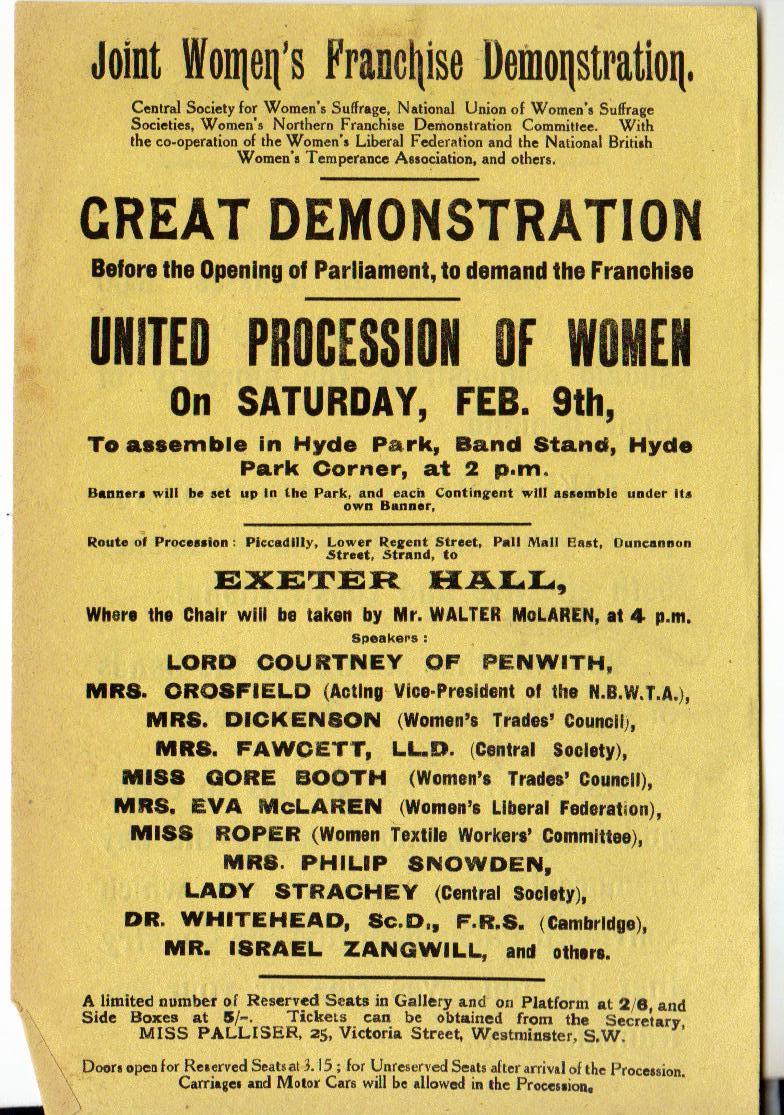 Flyer advertising the NUWSS ‘Mud March’
Flyer advertising the NUWSS ‘Mud March’Up the Strand it was a great crowd watching – some of the remarks were most amusing. ‘Here comes the class’ and two quite smart men standing by the kerb ‘I say look at those nice girls – positively disgraceful I call it.’ Then ‘Ginger hair – dark hair – and fair hair’ ‘Oh! What nice girls’ to Miss Doake, Agnes and I. Several asked if we had brought our sweethearts and made remarks to express their surprise at our special little band. ‘All the prizes in this lot’ etc. The mud was awful. Agnes and I wore galoshes so our feet were alright but we got dreadfully splashed. It was quite a business turning into the Exeter Hall. A band was playing merrily all the time – the one which had led the procession – and there was one not far off us. Three altogether, I was told.
 Exeter Hall in 1905
Exeter Hall in 1905We got good seats and of course had to wait some time before the meeting started – it was just after 4 pm when it did – but there was a ladies’ orchestra performing and playing very well and a lady at the organ in between whiles. The meeting was splendid. Mr Walter McLaren in the Chair and Israel Zangwill as chief speaker – he was so splendid and most witty. Miss Gore Booth – Mrs Fawcett – Mrs Eva McLaren – Lady Strachey and several other ladies spoke and Keir Hardie made an excellent speech. It was altogether a wonderful and memorable afternoon – and felt we were making history – but after all I don’t know, I am sure, what will come of it. The MPs seem to have cheated and thoroughly ‘had’ us all over it. They wanted the Liberal Women’s help to get into the House and now they don’t care two straws or they are frightened of us. We walked up to Tottenham Court Road and came home by bus. It was nearly 7 o’clock when we got in. .. I felt bitterly tired all the evening after the excitement.
Dramatis Personae for this entry
Agnes, Kate’s elder sister
Mickie, Kate’s beloved dog
Alexandra and her sister, Gladys, lived at 10 Linden Gardens. It was under their influence that Kate had joined the London Society for Women’s Suffrage.
Violette Mary Doake (b 1888) her parents were Irish, which may account for the red hair. Her mother, Mary Elizabeth Doake, was also a suffragist. Her father, Richard Baxter Doake, described in the 1911 census as a ‘tea planter’, was elected as a Progressive party member in 1892 to the LCC seat relinquished by Frederick Frye. In 1901 the Doakes lived at 24 Stanley Gardens, close to the Fryes. By 1911 they had moved to 25 Ladbroke Gardens.
Walter McLaren and his wife, Eva were members of a family of long-standing supporters of women’s suffrage. He had been Liberal MP for Crewe in the 1890s and regained the seat in 1910.
Israel Zangwill, Jewish novelist and very effective writer and speaker in support of women’s suffrage
Lady Strachey had worked for women’s suffrage since the 1860s. She remarked that after this march she had to boil her skirt.
Keir Hardie, first Independent Labour Party MP. He had strongly supported a motion in favour of women’s suffrage at the Labour party conference on 26 January
Campaigning for the Vote: Kate Parry Frye’s Suffrage Diary edited by Elizabeth Crawford
For a full description of the book click here
Wrap-around paper covers, 226 pp, over 70 illustrations, all from Kate Frye’s personal archive.
ISBN 978 1903427 75 0
Copies available from Francis Boutle Publishers, or from Elizabeth Crawford – elizabeth.crawford2017@outlook.com (£14.99), or from all good bookshops.
- Campaigning for the Vote– Front and back cover of wrappers
You can also listen here to a Radio 4 programme as Anne McElvoy and I follow the route of the ‘Mud March’.
Copyright
Book of the Week: Margaret Sanger, Woman And The New Race – Kitty Marion’s copy – rich with suffrage and Sanger associations
Posted by womanandhersphere in Book of the Week on October 2, 2012
Margaret Sanger, Woman And The New Race, published by Brentano’s (NY), 1921 (3rd printing) – Kitty Marion’s copy
Margaret Sanger spearheaded the birth-control campaign in the US. In this book, first published in 1920, she writes: ‘The most far-reaching social development of modern times is the revolt of woman against sex servitude. The most important force in the remaking of the world is a free motherhood’. The Introduction to the book is by Havelock Ellis, one of several leading thinkers with whom she had an affair.
In October 1914 Margaret Sanger fled from the US to England while on bail for violating US postal obscenity laws – the charge was that of sending through the post copies of her radical feminist journal, The Woman Rebel, which advocated the use of contraception. She remained in England until October 1915. Coincidentally it was in October 1915 that Kitty Marion, a former, German-born, militant suffragette, set sail for the US. Once in New York she worked for many years for Margaret Sanger, her role being that of street seller of Sanger’s Birth Control Review.
In England in 1913 Kitty Marion had been sentenced to three years’ imprisonment for her part in the burning of the grandstand at the Hurst Park racecourse (as retaliation for the death of Emily Wilding Davison)- although, after going on hunger and thirst strike, she was released under the Cat and Mouse Act. It would appear that, on the run, she was one of the WSPU’s most active arsonists, although she evaded detection for much of the destruction she committed. In New York, on 14 October 1918, she was again given a prison sentence – this time for distributing Birth Control Review.
This particular copy of this book brings together these various histories. The free front endpaper bears the ink inscription, in Margaret Sanger’s handwriting – ‘Margaret Sanger, New York, Oct 14-1921.
Underneath this is written ‘zum Andenken! Kitty Marion’ [translated from German: In Memory!]. This inscription obviously commemorates the 3rd anniversary of Kitty Marion’s imprisonment – of which Margaret Sanger had at the time written ‘We glory in her deed’. I think the second part of the endpaper inscription may be Kitty Marion’s hand. For although the ink looks much the same as the Sanger message, I think the writing is different.
Yet another layer of suffrage association is revealed by the ownership signature, written faintly in pencil in the top right corner of the same page. It is that of Maud Fussell, another former member of the WSPU – and, again, one who suffered imprisonment.
My reconstruction of the history of the book is that it was signed by Margaret Sanger for Kitty Marion and was subsequently given by Kitty Marion to Maud Fussell. It was sold to me along with other books that had been in Maud Fussell’s possession.
The book is in good condition and is a particularly interesting association copy. Price £165 plus postage.
To buy: please contact me at e.crawford@sphere20.freeserve.co.uk
Kate Frye’s Suffrage Diary: Spring 1908 – Suffrage Hope – WSPU in Albert Hall ‘a little too theatrical but very wonderful’
Posted by womanandhersphere in Kate Frye's suffrage diary on September 26, 2012
Another extract from Kate Frye’s manuscript diary. An edited edition of later entries (from 1911), recording her work as a suffrage organiser, is published as Campaigning for the Vote: Kate Parry Frye’s suffrage diary.
Kate’s MP, Henry Yorke Stanger, was the promoter of the current Enfranchisement Bill – the latest in the long line that stretched back through the latter half of the 19th century. Despite, as Kate describes, the bill passing its second reading, the government eventually refused to grant facilities to further the debate. However, that blow was yet to come as Kate records in these entries details of the suffrage meetings she attended in February and March 1908. She had the knack of always being present on the great occasions – and on 19 March was in the Albert Hall to witness the rousing – and profitable – reception given to Mrs Pankhurst on her release from prison.
Dramatis personae:
Miss Harriet Cockle, was 37 years old, an Australian woman of independent means, lving at 34 de Vere gardens, Kensington.
Mrs Philip Snowden – Ethel Snowden (1880-1951) wife of the ILP politician, Philip Snowden.
Mrs Clara Rackham (1875-1966) was regarded as on the the NUWSS’s best speakers. In 1910 she became president of the NUWSS’s Eastern Federation, was founder of the Cambridge branch of the Women’s Co-operative Guild, and was sister-in-law to Arthur Rackham, the book illustrator.
Margery Corbett (1882-1981- later Dame Margery Corbett-Ashby) was the daughter of a Liberal MP. At this time she was secretary of the NUWSS.
Mrs Fanny Haddelsey,wife of a solicitor, lived at 30 St James’s Square, Holland Park.
Mrs Stanbury had been an organiser for NUWSS as far back as 1890s.
Tuesday February 25th 1908 [London-25 Arundel Gardens]
We got home at 5.15 and had tea. Then I did my hair and tidied myself and Agnes and I ate hot fish at 6.30 and left soon after in a downpour of rain for the Kensington Town Hall – we did get wet walking to the bus and afterwards. We got there at 7 o’clock to steward – the doors were opening at 7.30 and the meeting started at 8.15. I was stewarding in the hall downstairs and missed my bag – purse with 6/- and latch Key etc – very early in the evening which rather spoilt the evening for me as I felt sure it had been stolen. It was a South Kensington Committee of the London Society for Woman’s Suffrage and we were stewarding for Miss Cockle. It was a good meeting but not crowded but, then, what a night. Miss Bertha Mason in the Chair. The speech of the evening was Mrs Philip Snowdon, who was great, and Mrs Rackham, who spoke well. The men did not do after them and poor Mr Stanger seemed quite worn out and quoted so much poetry he made me laugh. Daddie had honoured us with his presence for a little time and had sat on the platform – so I feel he has quite committed himself now and will have no right to go back on us. We were not in till 12.20 and then sat some time over our supper.
Wednesday February 26th 1908
Before I was up in the morning Mother came up in my room with my bag and purse and all quite safe. It had been found and the Hall Door Keeper had brought it. I was glad because of the Latch Key. Daddie generously had paid me the 6/- which I was able to return.
Friday February 28th 1908
Mr Stanger’s Woman’s Suffrage Bill has passed the second reading. I had to wait to see the Standard before going to my [cooking] class. That is very exciting and wonderful – but of course we have got this far already in past history. Oh! I would have liked to have been there.
MargWednesday March 11th 1908
To 25 Victoria Street and went to the 1st Speakers Class of the N.[ational] S.[ociety] of W.[omen’s] S.[uffrage]. I was very late getting there and there was no one I knew so I did not take any part in the proceedings and felt very frightened. But Alexandra Wright came in at the end and I spoke to Miss Margery Corbett and our instructoress, Mrs Brownlow. And then I came home with Alexandra from St James’s Park station to Notting Hilll Gate.
Thursday March 12th 1908
Mother went to a Lecture for the NKWLA [North Kensington Women’s Liberal Association] at the Club and Agnes and I started at 8 o’clock and walked to Mrs Haddesley [sic] for a drawing-room Suffrage Meeting at 8.30. Agnes and I stewarded and made ourselves generally useful. The Miss Porters were there and a girl who I saw at the Speakers’ Class on Wednesday. Alexandra was in the Chair and spoke beautifully – really she did. And Mrs Stanbury spoke. Mrs Corbett and Mrs George – all very good speakers. Mrs Stanbury was really great and there were a lot of questions and a lot of argument after, which made it exciting. It was a packed meeting but some of the people were stodgy. Miss Meade was there with a friend – her first appearance at anything of the kind she told us and she said it was all too much for her to take in all at once. The “class” girl walked with us to her home in HollandPark and we walked on home were not in till 11.45. I was awfully tired and glad of some supper and to get to bed.
Mrs Pankhurst had been arrested on 13 February as she led a deputation from the ‘Women’s Parliament’ in Caxton Hall to the House of Commons. She was released from her subsequent imprisonment on 19 March, going straight to the Albert Hall where the audience waiting to greet her donated £7000 to WSPU funds. Kate was there.
Thursday March 19th 1908
I had a letter in the morning from Miss Madge Porter offering me a seat at the Albert Hall for the evening and of course I was delighted….just before 7 o’clock I started for the Albert Hall. Walked to Notting Hill gate then took a bus. The meeting was not till 8 o’clock but Miss Porter had told me to be there by 7 o’clock. We had seats in the Balcony and it was a great strain to hear the speakers. It was a meeting of the National Women’s Social and Political Union – and Mrs Pankhurst, newly released from Prison with the other six was there, and she filled the chair that we had thought to see empty. It was an exciting meeting. The speakers were Miss Christabel Pankhurst, Mrs Pethick Lawrence, Miss Annie Kenney, Mrs Martel and the huge sums of money they collected. It was like magic the way it flowed in. It was all just a little too theatrical but very wonderful. Miss Annie Kenney interested me the most – she seems so “inspired” quite a second Joan of Arc. I was very pleased not to be missing so wonderful an evening and I think it very nice of Miss Porter to have thought of me. She is quite a nice girl of the modern but “girlie” sort – a Cheltenham girl and quite clever – but very like a lot of other girls. Coming out we met, strangely enough, Mrs Wright and Alexandra (Gladys was speaking at Peckham) and after saying good-bye to Miss Porter I walked home with them as far as Linden Gardens. Got in at 11.30 very tired indeed and glad of my supper. Mother was waiting up.
Campaigning for the Vote: Kate Parry Frye’s Suffrage Diary edited by Elizabeth Crawford
For a full description of the book click here
Wrap-around paper covers, 226 pp, over 70 illustrations, all drawn from Kate Frye’s personal archive.
ISBN 978 1903427 75 0
Copies available from Francis Boutle Publishers, or from Elizabeth Crawford – e.crawford@sphere20.freeserve.co.uk (£14.99 +UK postage £3. Please ask for international postage cost), or from all good bookshops. In stock at London Review of Books Bookshop, Foyles, National Archives Bookshop.
Kate Frye’s Diary: Learning the ‘Two Step’ for Suffrage
Posted by womanandhersphere in Kate Frye's suffrage diary on September 19, 2012
Another extract from Kate Frye’s manuscript diary. An edited edition of later entries (from 1911), recording her work as a suffrage organiser, is published as Campaigning for the Vote: Kate Parry Frye’s suffrage diary.
Working for women’s suffrage involved taking part in many different kinds of social activities. In the first month of 1908 Kate danced, stewarded and was lectured by Ford Madox Hueffer – all in the suffrage cause.
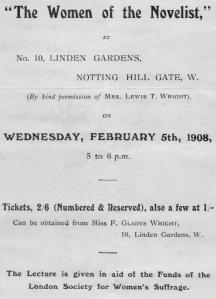
The flyer produced – presumably by the Wrights – for the lecture that Ford Madox Hueffer gave in their house. I wonder if the error in the spelling of his middle name was pointed out to them?
Dramatis personae for these entries:
‘Mrs Wright and the girls’: Mrs Lewis Wright and her daughters, Alexandra and Gladys, who then lived at 10 Linden Gardens. It was under their influence that Kate had joined the London Society for Women’s Suffrage, a constitutional suffrage society.
Geoffrey Stanger: the son of H.Y. Stanger, Liberal MP for North Kensington, who had introduced a women’s suffrage bill into the House of Commons.
Miss Mason: Bertha Mason, honorary treasurer of the National Union of Women’s Suffrage Socities – a suffragist of long-standing.
Miss Frances Sterling: joint honorary secretary of the NUWSS.
Ford Madox Hueffer (later Ford Madox Ford): author, then living in Kensington with Violet Hunt.
Friday January 10th 1908 [London: 25 Arundel Gardens, North Kensington]
I sat over the fire and had another little rest and got dressed early in my white satin dress. It is pretty – a charming frock – the nicest I have ever had, it seems to me. I did my hair Greek fashion with a silver and turquoise band round it which I have made myself – and though it’s me what says it and shouldn’t ‘I did look nice’. Even Mother said I did, I heard after from Agnes. Agnes’s dress was pretty too. And Mother has made hers beautifully but it hadn’t on a trace of style and she really did not look very nice……We had a private omnibus to the Grafton Galleries and got there about 9.15. Met Mrs Wright and her party just inside but by the time our four men had helped themselves we hadn’t many dances left. The girls introduced me to a few but I thought theirs rather a scratch lot – one boy wasn’t bad and Geoffrey Stanger, but one or two others I had I lost as soon as possible. It was a great pack – too many people for dancing in comfort somewhere about 300 and they have made for the London Society of Women’s Suffrage about £70…We stayed to the bitter end and I danced every dance except a few extra at supper time .. I learnt to do the Two Step with Mr Stanger and loved it. We reached home at 3.20 and were able to stir the fire into a blaze. John went off before 4 o’clock but we four sat over the fire talking till 4.30 and it was 5 o’clock before I was in bed as I always like to put some of my things away and tidy the room.
Thursday January 16th 1908
Changed at 6.30 and Agnes and I went off at 7.30 to Miss Mason’s (9 Hyde Park Place) for a Drawing-room Suffrage Meeting at which we had promised to Steward and get there at 8 o’clock for 8.30. We started to walk but we were all in our best and it started to drizzle and we took a cab from the top of the hill. The speakers were the Hon Bertrand Russell, Mr Mitchell Morton and Miss Frances Sterling. She made a most excellent speech and it was a most successful meeting. We did much good work in the way of getting members for the Society and it was all most encouraging and enthusiastic. They had a meeting here last night too – 70 people – but Alexandra said they were a most cold unenthusiastic audience – they could not do anything with them. She has paid Agnes and me a great compliment in saying ‘ I always like to see Agnes and you come into a room – then I know the thing will “go”’. I suppose we have a lot of personality and a lot of electrical excitement and it does help. John is quite in the movement now – though still apt to go back on us in the society of his own sex. .. These meetings are so exciting. I never feel like settling off after them.
Friday January 24th 1908
Changed after tea and at 5.30 Agnes and I went by motor bus from Notting Hill Gate to Oxford Circus and to the Queen’s Hall for the Liberal Federation Woman’s Suffrage Meeting. As we had been asked to act as Stewards and had to be there at 6 o’clock. We stewarded up in the Balcony but there was very little to be done. A good meeting, but not very full. But the audience was a very enthusiastic one and the speeches went well. Mrs Eva McLaren in the chair. Miss Balgarnie, Mrs Conybeare, Mrs Booth and the usual Liberal Women’s Federation people. It was a meeting for women only but there were a number of men stewards. The doors were opened at 7 o’clock and it commenced at 8 o’clock. Mother was there and we met at Oxford Circus and the three of us came home together by bus.
Wednesday February 5th 1908
They had quite a dozen awful Hampstead females there [at home] so we slipped quietly away and hurried to Notting Hill Gate so as to be at the Wrights (10 Linden Gardens) punctually at 4.45. Gladys had asked us to help them I stood in the hall and looked at tickets and sold others etc and later went up to hear the lecture from 5 to 6 by Mr Ford Maddox [sic] Heuffer on the Women of the Classical Novelist of England. It was most interesting and a breezy discussion followed. We got in at 6.30 .. I was very tired but I worked till 11 o’clock directing envelopes for the South Kensington Committee of the L.S.W.S. for a meeting to be held at the Town Hall on the 25th inst.
Campaigning for the Vote: Kate Parry Frye’s Suffrage Diary edited by Elizabeth Crawford
For a full description of the book click here
Wrap-around paper covers, 226 pp, over 70 illustrations, all drawn from Kate Frye’s personal archive.
ISBN 978 1903427 75 0
Copies available from Francis Boutle Publishers, or from Elizabeth Crawford – e.crawford@sphere20.freeserve.co.uk (£14.99 +UK postage £3. Please ask for international postage cost), or from all good bookshops. In stock at London Review of Books Bookshop, Foyles, National Archives Bookshop.
Collecting Suffrage: The Hunger Strike Medal
Posted by womanandhersphere in Collecting Suffrage on August 11, 2012
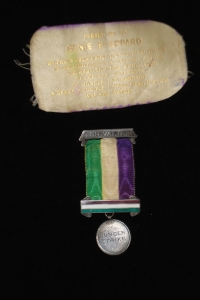 One of the most iconic items to add to a suffrage collection is a WSPU hunger-strike medal.
One of the most iconic items to add to a suffrage collection is a WSPU hunger-strike medal.
These medals were first presented by the WSPU at a ceremony in early August 1909, given to women who had gone on hunger strike while serving a prison sentence handed down as punishment for an act of suffrage militancy.
The medals comprise a silver pin bar engraved ‘For Valour’, a hanging length of ribbon in the purple, white and green colours, and either a silver or a striped enamel bar, from which hangs a silver circle with the name of the presentee on one side and ‘Hunger striker’ on the other. If the ribbon terminates in a silver bar, this is engraved with a date denoting the day of the owner’s arrest. The enamelled purple, white and green bars are engraved on the reverse, for example sculptor Edith Downing’s medal that I once sold is engraved with ‘Fed by Force 1/3/12’. This was the date of her imprisonment that resulted in a hunger strike and forcible feeding.
Some medals, such as the one Emily Wilding Davison is wearing in my 6 August ‘Suffrage Stories’ post, carry more than one bar, indicating multiple hungerstrikes.
Each medal was presented in a purple box, with a green velvet lining. As can be seen in the photograph, a piece of white silk that originally went inside the lid was printed in gold with: ‘Presented to [name] by the Women’s Social and Political Union in recognition of a gallant action, whereby through endurance to the last extremity of hunger and hardship a great principle of political justice was vindicated’.
These medals were made by Toye, a well-known Clerkenwell firm, and cost the WSPU £1 each – the medals now sell for thousands of pounds. They were treasured by their recipients who , in their old age, still proudly wore them on suffrage occasions; they are treasured today by collectors who recognise the bravery of the women to whom they were awarded.
Kate Frye’s Suffrage Diary: first canvassing
Posted by womanandhersphere in Kate Frye's suffrage diary on August 9, 2012
Another extract from Kate Parry Frye’s manuscript diary. These entries dates from the period two years before Campaigning for the Vote – the edited version of her diary published by Francis Boutle Publishers – begins. This episode marks the first time Kate is involved in active doorstep – or, at least, letterbox – campaigning. She was to do a great deal more of it over the next few years.
Gladys Wright was a university-educated young woman, a fellow Kensington resident, and already an active suffragist, working for the London NUWSS – non-militant – society.
‘The Grove’ was Westbourne Grove, the local shopping mecca, home of Whiteleys, the Universal Provider.
The Fryes were – or had been – very friendly with William Whiteley, who had been gunned down in his own store just two months earlier.
Monday 19 March 1907 [25 ArundelGardens, Notting Hill]
Up to breakfast and found a letter from Gladys Wright asking me to do some work with them for the Suffrage. A Motor Bus to Strakers in the Edgware Road where I bought 500 envelopes. Changed my things and wrote letters till dinner time – then after dinner started addressing my envelopes and did about half until 11.30 when I went to bed very tired.
Thursday March 19th 1907
Changed my dress after lunch then wrote some letters till tea time. Our At Home day but no visitors arrived. After tea I sat and finished directing my envelopes.
Thursday March 20th 1907
Up at 11.30. The notices had come for the envelopes so I filled Lansdowne Road and Lansdowne Crescent. Sent Agnes [her sister] out with them. I took out ArundelGardens and Powis Square – a most awful place – high flats – and Powis something else. After lunch Agnes and I went out again delivering – more Powis and Colvilles. Colville Mansions nearly killed us the stairs were awful. We got in about 4 o’clock feeling very tired.
Thursday March 21st 1907
Mother went to Committee [Liberal] meeting in the afternoon. Agnes and I went out at 3 o’clock and delivered the last two streets of the meeting notices – then went to the Grove and did a little shopping.
Campaigning for the Vote: Kate Parry Frye’s Suffrage Diary edited by Elizabeth Crawford
For a full description of the book click here
Wrap-around paper covers, 226 pp, over 70 illustrations, all drawn from Kate Frye’s personal archive.
ISBN 978 1903427 75 0
Copies available from Francis Boutle Publishers, or from Elizabeth Crawford – e.crawford@sphere20.freeserve.co.uk (£14.99 +UK postage £3. Please ask for international postage cost), or from all good bookshops. In stock at London Review of Books Bookshop, Foyles, National Archives Bookshop.
Collecting Suffrage: Punch cartoon
Posted by womanandhersphere in Collecting Suffrage on August 8, 2012
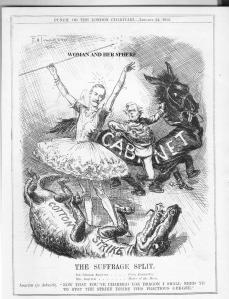 21 January 1912 – full page – ‘The Suffrage Split’. Sir George Askwith (the charismatic industrial conciliator), as ‘Fairy Peacemaker’, has tamed the dragon of the Cotton Strike – and Asquith, wrestling to keep a seat on the Cabinet horse turns to him ‘Now that you’ve charmed yon dragon I shall need ye to stop the strike inside this fractious gee-gee.’
21 January 1912 – full page – ‘The Suffrage Split’. Sir George Askwith (the charismatic industrial conciliator), as ‘Fairy Peacemaker’, has tamed the dragon of the Cotton Strike – and Asquith, wrestling to keep a seat on the Cabinet horse turns to him ‘Now that you’ve charmed yon dragon I shall need ye to stop the strike inside this fractious gee-gee.’
In very good condition £10 plus £1 postage.
To buy contact: e.crawford@sphere20.freeserve.co.uk
Kate Frye’s Suffrage Diary: 14 March 1907
Posted by womanandhersphere in Kate Frye's suffrage diary on August 2, 2012
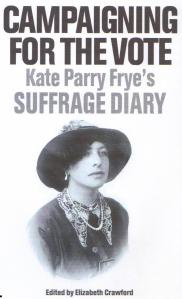 Kate is now being swept up into general suffrage enthusiasm – as a member of the NUWSS London society. The hostess of this meeting at 60 Onslow Gardens was Mariana (c 1853-1933), wife of Hylton Dale, a coke and coal merchant.. She was a University of London graduate, a member of the Fabian Society, author of Child Labour under Capitalism and active in many causes, such as the National Association of Women’s Lodging Houses, as well as the suffrage movement. As Kate mentions, one of the purposes of the meeting was to gather signatures for ‘Miss Black’s Declaration’.
Kate is now being swept up into general suffrage enthusiasm – as a member of the NUWSS London society. The hostess of this meeting at 60 Onslow Gardens was Mariana (c 1853-1933), wife of Hylton Dale, a coke and coal merchant.. She was a University of London graduate, a member of the Fabian Society, author of Child Labour under Capitalism and active in many causes, such as the National Association of Women’s Lodging Houses, as well as the suffrage movement. As Kate mentions, one of the purposes of the meeting was to gather signatures for ‘Miss Black’s Declaration’.  Clementina Black [left], journalist and author and, like Mrs Dale, always concerned for the working woman, had formed a Women’s Franchise Declaration Committee four months earlier, in November 1906, in one of the many, alas futile, attempts to disprove the statement that women did not really want the vote. It sent out forms to women engaged in business and the professions and at the time of Kate’s contribution the Committee had already gathered nearly 31,000 signatures – drawn particularly from the fields of education, social work, office work, trade, and art. Needless to say, the resulting Declaration, with its 257,000 signatures, was brushed aside by the government, as had so many other attempts to reason made by suffrage societies over the previous 40 years. It is little wonder that the call to militancy met with such success.
Clementina Black [left], journalist and author and, like Mrs Dale, always concerned for the working woman, had formed a Women’s Franchise Declaration Committee four months earlier, in November 1906, in one of the many, alas futile, attempts to disprove the statement that women did not really want the vote. It sent out forms to women engaged in business and the professions and at the time of Kate’s contribution the Committee had already gathered nearly 31,000 signatures – drawn particularly from the fields of education, social work, office work, trade, and art. Needless to say, the resulting Declaration, with its 257,000 signatures, was brushed aside by the government, as had so many other attempts to reason made by suffrage societies over the previous 40 years. It is little wonder that the call to militancy met with such success.
Of the speakers, Mrs Stanbury was a member of the Fabian Women’s Group and an organiser for NUWSS; Frances Sterling, another Kensington resident, was joint honorary secretary of the NUWSS.
Thursday March 14th 1907 [25 Arundel Gardens, North Kensington]
Changed my dress after lunch and soon after 3 o’clock Agnes and I walked to Notting Hill Gate and went by train to South Kensington and went to Mrs Hylton Dale’s house in Onslow Gardens to a Woman’s Suffrage Meeting. Alexandra and Gladys Wright were to have done all the work of getting it up and asked us to act as Stewards. So we had to get there punctually at 3.45 to receive instructions, leave our coats, put on badges etc and get some tea. Tea was at 4 o’clock, the meeting at 4.30. Such a lovely house, a beautiful tea – everything so nice – and a glorious room upstairs for the meeting and it was packed. One of the doors had to be taken out and the people sat up and down the stairs and crowded the landings. Such a rich, fashionable, beautifully-dressed audience for the most part. I was busy getting signatures before the meeting began and after it was over and Gladys and I collected. It really didn’t seem to matter asking those rich people to give. We collected £3 3s and got signatures to Miss Black’s Declaration. They want a million names to it. At present there are only about the first hundred thousand. It was a most interesting meeting – such an unusual class of people and I loved working. A Mrs Stanbury was in the Chair. She was fine. Miss Clementina Black, Miss Sterling and Mr Walter McLaren MP were amongst the speakers and the questions asked and answered afterwards were most amusing. One girl I was very taken with – she really did look beautiful and her sister was most fascinating – I got them to sign and found the one was Lilias Waldegrave the actress. Agnes and I didn’t realise how tired we were till we came away – we had been standing all the time and getting so excited. We were not in till after 7 o’clock.
Campaigning for the Vote: Kate Parry Frye’s Suffrage Diary edited by Elizabeth Crawford
For a full description of the book click here
Wrap-around paper covers, 226 pp, over 70 illustrations, all drawn from Kate Frye’s personal archive
NOW, ALAS, OUT OF PRINT
Suffragette postcards: suffragettes and policemen 3
Posted by womanandhersphere in Collecting Suffrage on July 27, 2012
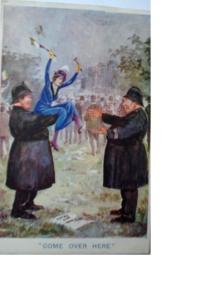 Another in this week’s theme of ‘suffragettes and policemen’.
Another in this week’s theme of ‘suffragettes and policemen’.
Two burly policeman are playing games with tiny (elegant, for a change) suffragette. Waving the tools of her trade – a hammer and flags, she is held aloft by one who looks as though he intends to lob her over to the other, who is waiting with outstretched arms. A ‘Votes for Women’ placard lies on the ground between them. Published by Inter-Art Co., Red Lion Sq, London WC. Good – slightly rubbed at edges – posted in 1913. £35 post free.
Kate Frye’s Suffrage Diary: 3 December 1906
Posted by womanandhersphere in Kate Frye's suffrage diary on July 26, 2012
 Kate’s family had always taken an interest in politics; her father had been Liberal MP for North Kensington in the 1890s and into the 20th century her mother was the president of the North Kensington Women’s Liberal Association. However, the meeting described below is the first occasion that Kate mentions in her diary her attendance at a specifically ‘suffrage’ meeting and of the disturbances that had been caused by the WSPU’s ‘rowdy attacks’.
Kate’s family had always taken an interest in politics; her father had been Liberal MP for North Kensington in the 1890s and into the 20th century her mother was the president of the North Kensington Women’s Liberal Association. However, the meeting described below is the first occasion that Kate mentions in her diary her attendance at a specifically ‘suffrage’ meeting and of the disturbances that had been caused by the WSPU’s ‘rowdy attacks’.
At 8 o’clock [evening] Agnes [Kate’s elder sister] and I went off to KensingtonTown Hall to a Woman’s Suffrage meeting – got up by the Central Society. Lady Frances Balfour was presiding. We went by bus – when we got there the large hall was packed. Alexandra Wright was at the top of the stairs and directed us up to the overflow meeting and that was packed too. After a bit the speakers came in to us – the Hon Mrs Bertrand Russell, Miss Gore Booth, Lady Frances Balfour and Mr Cameron Corbett M.P. I heard excellent speeches all of them – they really did put the case in a nutshell and were most instructive and interesting.
Then Gladys Wright came and fetched me out and came and asked me to act as a Steward and collect – then later she went in for Agnes – and we both did what we could. We collected in the Gallery first – then later I was stationed to get the people as they came out. It was very amusing really – and I got so hot and excited – off my head with it – we certainly are in the thick of things always. Some of the people gave a lot – others shook their heads and frowned. One man said I wanted too much – to marry as well as a Vote. I had quite a flirtation on the stairs with a big smart young man – who stopped to ask me a question – he didn’t seem to know anything about anything and when he said the speaker had referred to Earl Percy as ‘half asleep’ – I said ‘That is true about a great many people’ – he did laugh.
I am afraid I felt I was more like a helper at a Bazaar than at so grave a thing as a Woman’s Suffrage Meeting – but then it is so hard for me to be serious about anything – but I am in earnest – I really do feel a great belief in the need of the Vote for Women if only as a means of Education. I feel my prayer for Women in the words of George Meredith ‘More brains, Oh Lord, more brains.’ But we are coming along and not slowly by any means. Of course all these rowdy attacks on the Ministers and these imprisonments have sounded coarse and unpleasant and the jokery made of it most bad for the cause – but women have waited patiently for so long the sort of women who have gone for the matter in this rowdy method are not the best educated or most refined amongst our members.
At this meeting every thing passed off in a most orderly dignified spirit – and the speeches from the women were delightful and must have come as a revelation to many of the audience. There was a declaration there for any working woman there who cared to sign – a number did – I did – as I have a profession [Kate was a rather unsuccessful actress]. Naturally they don’t want crowds of names without any meaning or strength in them. We came home after hearing the amount collected nearly £20 – about the cost of getting up a meeting – the reason for the collection. Bus to Notting Hill – got in soon after 10.30 – in a frenzy of excitement.
Campaigning for the Vote: Kate Parry Frye’s Suffrage Diary edited by Elizabeth Crawford
For a full description of the book click here
Wrap-around paper covers, 226 pp, over 70 illustrations, all drawn from Kate Frye’s personal archive.
ISBN 978 1903427 75 0
Copies available from Francis Boutle Publishers, or from Elizabeth Crawford – elizabeth.crawford2017@outlook.com (£14.99 +UK postage £3. Please ask for international postage cost), or from all good bookshops – and Amazon.
Suffragette postcards: suffragettes and policemen 2
Posted by womanandhersphere in Collecting Suffrage on July 25, 2012
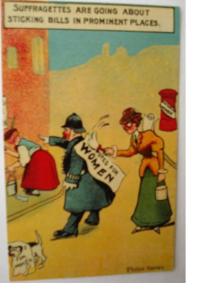 Here is another card in the ‘Philco Series’, titled ‘SUFFRAGETTES ARE GOING ABOUT STICKING BILLS IN PROMINENT PLACES’ and in this particular case that is pasting a ‘Votes for Women’ on the back of a policeman, who is in the process of accosting another bill-sticking suffragette. Needless to say the women are the usual stereotypical trilby-wearing, bespectacled harridens. In the scene a pillar box and a dog have also been plastered with V f W posters. The message on the reverse – written in pencil from the same sender to the same recipient as that of the card in the previous ‘Collecting Suffrage’ post – that is Win to Mrs James – reads ‘And the best of wishes for a happy Christmas. The suffragettes what and how they do things in London.’ Very good – unposted £45 post free. NOW SOLD
Here is another card in the ‘Philco Series’, titled ‘SUFFRAGETTES ARE GOING ABOUT STICKING BILLS IN PROMINENT PLACES’ and in this particular case that is pasting a ‘Votes for Women’ on the back of a policeman, who is in the process of accosting another bill-sticking suffragette. Needless to say the women are the usual stereotypical trilby-wearing, bespectacled harridens. In the scene a pillar box and a dog have also been plastered with V f W posters. The message on the reverse – written in pencil from the same sender to the same recipient as that of the card in the previous ‘Collecting Suffrage’ post – that is Win to Mrs James – reads ‘And the best of wishes for a happy Christmas. The suffragettes what and how they do things in London.’ Very good – unposted £45 post free. NOW SOLD
Suffragette postcards: suffragettes and policemen
Posted by womanandhersphere in Collecting Suffrage on July 24, 2012
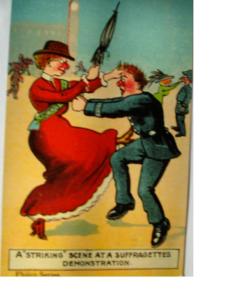 The increased activity of the women’s suffrage campaign in the early years of the 20th century coincided with the golden age of the postcard. It proved to be a subject very popular with the burgeoning number of commercial postcard publishers and cards with a ‘suffragette’ theme outnumber those relating to other contemporary campaigns – such as Tariff Reform and Home Rule.
The increased activity of the women’s suffrage campaign in the early years of the 20th century coincided with the golden age of the postcard. It proved to be a subject very popular with the burgeoning number of commercial postcard publishers and cards with a ‘suffragette’ theme outnumber those relating to other contemporary campaigns – such as Tariff Reform and Home Rule.
Without too much effort, anyone interested can still build up a collection of cards reflecting the varying views of Edwardian society on women’s desire for citizenship – and their methods of achieving it. The suffrage societies themselves all produced cards – portraits of their leaders or photographs of great suffrage occasions – although they are vastly outnumbered by cards produced by the commercial publishers.
The incongruence of women battling with policemen – as on ‘Black Friday’ in November 1910 – certainly caught the publishers’ attention and there are many variations on the theme. This card was published by Philco Publishers, whose office was in Holborn Place – very close to WSPU headquarters. This card was not posted but is written to ‘Mrs James’. The message reads ‘I do not know what you will think of this. But this is suffragettes in vengeance and in their battle array.’
The stereotypical harridan (trilby hat, glasses, high-colouring, big nose) wearing ‘Votes for Women’ sash wields her umbrella as she kicks a policeman. In the background another, similar, scene is enacted. There is a tall clock tower – which might just be intended as Big Ben – at the very back of the scene, attached to a misty building. This card, which is in good condition, was one of a series. It is available for sale from me: £45 post free. NOW SOLD
See the August 2012 issue of BBC History Magazine for Prof June Purvis’s article on ‘suffragette’ cards published by commercial publishers and click here for details of her very interesting and informative accompanying podcast (June’s piece begins 20 minutes into the recording).
